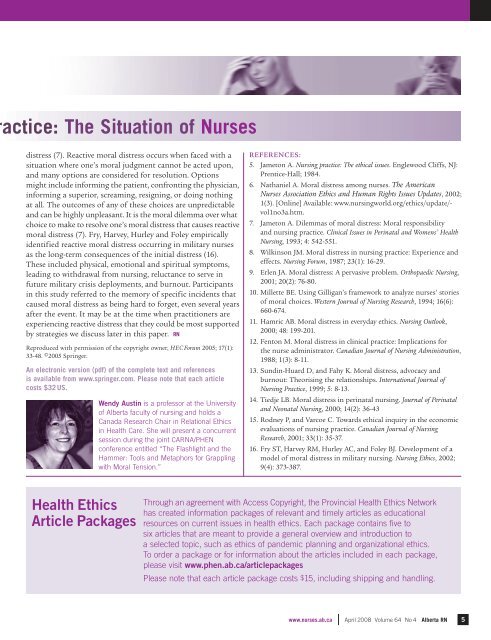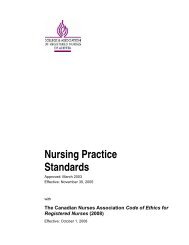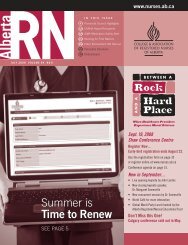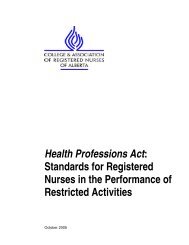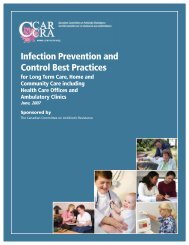I am a nurse. - College & Association of Registered Nurses of Alberta
I am a nurse. - College & Association of Registered Nurses of Alberta
I am a nurse. - College & Association of Registered Nurses of Alberta
You also want an ePaper? Increase the reach of your titles
YUMPU automatically turns print PDFs into web optimized ePapers that Google loves.
actice: The Situation <strong>of</strong> <strong>Nurses</strong><br />
distress (7). Reactive moral distress occurs when faced with a<br />
situation where one’s moral judgment cannot be acted upon,<br />
and many options are considered for resolution. Options<br />
might include informing the patient, confronting the physician,<br />
informing a superior, scre<strong>am</strong>ing, resigning, or doing nothing<br />
at all. The outcomes <strong>of</strong> any <strong>of</strong> these choices are unpredictable<br />
and can be highly unpleasant. It is the moral dilemma over what<br />
choice to make to resolve one’s moral distress that causes reactive<br />
moral distress (7). Fry, Harvey, Hurley and Foley empirically<br />
identified reactive moral distress occurring in military <strong>nurse</strong>s<br />
as the long-term consequences <strong>of</strong> the initial distress (16).<br />
These included physical, emotional and spiritual symptoms,<br />
leading to withdrawal from nursing, reluctance to serve in<br />
future military crisis deployments, and burnout. Participants<br />
in this study referred to the memory <strong>of</strong> specific incidents that<br />
caused moral distress as being hard to forget, even several years<br />
after the event. It may be at the time when practitioners are<br />
experiencing reactive distress that they could be most supported<br />
by strategies we discuss later in this paper. RN<br />
Reproduced with permission <strong>of</strong> the copyright owner, HECForum 2005; 17(1):<br />
33-48. © 2005 Springer.<br />
An electronic version (pdf) <strong>of</strong> the complete text and references<br />
is available from www.springer.com. Please note that each article<br />
costs $32 US.<br />
Health Ethics<br />
Article Packages<br />
Wendy Austin is a pr<strong>of</strong>essor at the University<br />
<strong>of</strong> <strong>Alberta</strong> faculty <strong>of</strong> nursing and holds a<br />
Canada Research Chair in Relational Ethics<br />
in Health Care. She will present a concurrent<br />
session during the joint CARNA/PHEN<br />
conference entitled “The Flashlight and the<br />
H<strong>am</strong>mer: Tools and Metaphors for Grappling<br />
with Moral Tension.”<br />
REFERENCES:<br />
5. J<strong>am</strong>eton A. Nursing practice: The ethical issues. Englewood Cliffs, NJ:<br />
Prentice-Hall; 1984.<br />
6. Nathaniel A. Moral distress <strong>am</strong>ong <strong>nurse</strong>s. The American<br />
<strong>Nurses</strong> <strong>Association</strong> Ethics and Human Rights Issues Updates, 2002;<br />
1(3). [Online] Available: www.nursingworld.org/ethics/update/vol1no3a.htm.<br />
7. J<strong>am</strong>eton A. Dilemmas <strong>of</strong> moral distress: Moral responsibility<br />
and nursing practice. Clinical Issues in Perinatal and Womens’ Health<br />
Nursing, 1993; 4: 542-551.<br />
8. Wilkinson JM. Moral distress in nursing practice: Experience and<br />
effects. Nursing Forum, 1987; 23(1): 16-29.<br />
9. Erlen JA. Moral distress: A pervasive problem. Orthopaedic Nursing,<br />
2001; 20(2): 76-80.<br />
10. Millette BE. Using Gilligan’s fr<strong>am</strong>ework to analyze <strong>nurse</strong>s’ stories<br />
<strong>of</strong> moral choices. Western Journal <strong>of</strong> Nursing Research, 1994; 16(6):<br />
660-674.<br />
11. H<strong>am</strong>ric AB. Moral distress in everyday ethics. Nursing Outlook,<br />
2000; 48: 199-201.<br />
12. Fenton M. Moral distress in clinical practice: Implications for<br />
the <strong>nurse</strong> administrator. Canadian Journal <strong>of</strong> Nursing Administration,<br />
1988; 1(3): 8-11.<br />
13. Sundin-Huard D, and Fahy K. Moral distress, advocacy and<br />
burnout: Theorising the relationships. International Journal <strong>of</strong><br />
Nursing Practice, 1999; 5: 8-13.<br />
14. Tiedje LB. Moral distress in perinatal nursing. Journal <strong>of</strong> Perinatal<br />
and Neonatal Nursing, 2000; 14(2): 36-43<br />
15. Rodney P, and Varcoe C. Towards ethical inquiry in the economic<br />
evaluations <strong>of</strong> nursing practice. Canadian Journal <strong>of</strong> Nursing<br />
Research, 2001; 33(1): 35-37.<br />
16. Fry ST, Harvey RM, Hurley AC, and Foley BJ. Development <strong>of</strong> a<br />
model <strong>of</strong> moral distress in military nursing. Nursing Ethics, 2002;<br />
9(4): 373-387.<br />
Through an agreement with Access Copyright, the Provincial Health Ethics Network<br />
has created information packages <strong>of</strong> relevant and timely articles as educational<br />
resources on current issues in health ethics. Each package contains five to<br />
six articles that are meant to provide a general overview and introduction to<br />
a selected topic, such as ethics <strong>of</strong> pandemic planning and organizational ethics.<br />
To order a package or for information about the articles included in each package,<br />
please visit www.phen.ab.ca/articlepackages<br />
Please note that each article package costs $15, including shipping and handling.<br />
www.<strong>nurse</strong>s.ab.ca April 2008 Volume 64 No 4 <strong>Alberta</strong> RN 5


